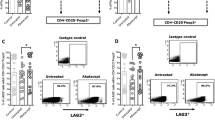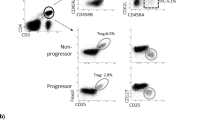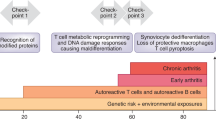Abstract
T cells regulate the disease process in rheumatoid arthritis (RA) on multiple levels and represent a logical choice for anti-inflammatory therapy. In the inflamed joint they promote neoangiogenesis and lymphoid organogenesis, and stimulate synoviocyte proliferation and development of bone-eroding osteoclasts. The design of T-cell-targeted therapies for RA needs to take into account the uniqueness of T-cell generation, turnover and differentiation in affected patients. Patients accumulate 'old' T cells that respond to alternate regulatory signals because of an accelerated immune aging process; any therapeutic interventions that increase the replicative stress of T cells should, therefore, be avoided. Instead, therapeutic approaches that raise the threshold for T-cell activation are more promising. As a rule, antigen-derived signals synergize with co-stimulatory signals to stimulate T cells; such co-stimulatory signals are now targeted in novel immunosuppressive therapies. An example is abatacept (soluble cytotoxic-T-lymphocyte-associated protein 4–immunoglobulin), which binds with high affinity to CD80/CD86 and effectively suppresses inflammatory activity in RA. The therapeutic benefits gained by disrupting T-cell co-stimulation indicate that the pathogenesis of RA is driven by a more generalized abnormality in T-cell activation thresholds rather than a highly selective action of arthritogenic antigens.
Key Points
-
T cells are key players in rheumatoid arthritis and, by virtue of their regulatory and effector functions, contribute to several disease pathways
-
T-cell activation requires integration of multiple signals, one of them deriving from antigen recognition and others from co-stimulatory receptors
-
Interfering with co-stimulatory signals can inhibit T-cell activation without the need to identify disease-relevant antigens
-
T-cell activation in rheumatoid arthritis occurs in the synovium as well as lymphoid organs, involving distinct co-stimulatory receptor–ligand pairs in each microenvironment
-
Patients with rheumatoid arthritis accumulate prematurely aged T cells that express novel regulatory receptors and respond to specific environmental cues
This is a preview of subscription content, access via your institution
Access options
Subscribe to this journal
Receive 12 print issues and online access
$209.00 per year
only $17.42 per issue
Buy this article
- Purchase on Springer Link
- Instant access to full article PDF
Prices may be subject to local taxes which are calculated during checkout



Similar content being viewed by others
References
Keen HI and Emery P (2005) How should we manage early rheumatoid arthritis? From imaging to intervention. Curr Opin Rheumatol 17: 280–285
Goronzy JJ and Weyand CM (2005) Rheumatoid arthritis. Immunol Rev 204: 55–73
Lipsky PE (2005) Integrating biologic therapy into the comprehensive care of patients with rheumatoid arthritis. J Rheumatol Suppl 72: 54–57
Pollard L and Choy E (2005) Rheumatoid arthritis: non-tumor necrosis factor targets. Curr Opin Rheumatol 17: 242–246
Lanzavecchia A and Sallusto F (2005) Understanding the generation and function of memory T cell subsets. Curr Opin Immunol 17: 326–332
Naylor K et al. (2005) The influence of age on T cell generation and TCR diversity. J Immunol 174: 7446–7452
Palacios EH and Weiss A (2004) Function of the Src-family kinases, Lck and Fyn, in T-cell development and activation. Oncogene 23: 7990–8000
Hermiston ML et al. (2002) Reciprocal regulation of lymphocyte activation by tyrosine kinases and phosphatases. J Clin Invest 109: 9–14
Macian F (2005) NFAT proteins: key regulators of T-cell development and function. Nat Rev Immunol 5: 472–484
O'Garra A and Robinson D (2004) Development and function of T helper 1 cells. Adv Immunol 83: 133–162
Watts TH (2005) TNF/TNFR family members in costimulation of T cell responses. Annu Rev Immunol 23: 23–68
Udagawa N (2003) The mechanism of osteoclast differentiation from macrophages: possible roles of T lymphocytes in osteoclastogenesis. J Bone Miner Metab 21: 337–343
Acuto O and Michel F (2003) CD28-mediated co-stimulation: a quantitative support for TCR signalling. Nat Rev Immunol 3: 939–951
Snyder MR et al. (2004) The double life of NK receptors: stimulation or co-stimulation? Trends Immunol 25: 25–32
Greenwald RJ et al. (2005) The B7 family revisited. Annu Rev Immunol 23: 515–548
Nurieva RI (2005) Regulation of immune and autoimmune responses by ICOS-B7h interaction. Clin Immunol 115: 19–25
Leibson PJ (2004) The regulation of lymphocyte activation by inhibitory receptors. Curr Opin Immunol 16: 328–336
Kang YM et al. (2002) CD8 T cells are required for the formation of ectopic germinal centers in rheumatoid synovitis. J Exp Med 195: 1325–1336
Weyand CM et al. (2005) B cells in rheumatoid synovitis. Arthritis Res Ther 7 (Suppl 3): S9–S12
Seyler TM et al (2005) BLyS and APRIL in rheumatoid arthritis. J Clin Invest 115: 3083–3092
Takemura S et al. (2001) T cell activation in rheumatoid synovium is B cell dependent. J Immunol 167: 4710–4718
Goronzy JJ and Weyand CM (2004) T-cell regulation in rheumatoid arthritis. Curr Opin Rheumatol 16: 212–217
Mor A et al. (2005) The fibroblast-like synovial cell in rheumatoid arthritis: a key player in inflammation and joint destruction. Clin Immunol 115: 118–128
Takemura S et al. (2001) Lymphoid neogenesis in rheumatoid synovitis. J Immunol 167: 1072–1080
Weyand CM and Goronzy JJ (2003) Ectopic germinal center formation in rheumatoid synovitis. Ann NY Acad Sci 987: 140–149
Weyand CM et al. (2001) Ectopic lymphoid organogenesis: a fast track for autoimmunity. Am J Pathol 159: 787–793
Taylor PC and Sivakumar B (2005) Hypoxia and angiogenesis in rheumatoid arthritis. Curr Opin Rheumatol 17: 293–298
Park YW et al. (2004) Thrombospondin 2 functions as an endogenous regulator of angiogenesis and inflammation in rheumatoid arthritis. Am J Pathol 165: 2087–2098
Klimiuk PA et al. (1999) Production of cytokines and metalloproteinases in rheumatoid synovitis is T cell dependent. Clin Immunol 90: 65–78
Kraan MC et al. (2004) T cells, fibroblast-like synoviocytes, and granzyme B+ cytotoxic cells are associated with joint damage in patients with recent onset rheumatoid arthritis. Ann Rheum Dis 63: 483–488
Verburg R et al. (2005) The outcome of intensive immunosuppression and autologous stemcell transplantation in patients with severe rheumatoid arthritis is associated with the composition of synovial T cell infiltration. Ann Rheum Dis 64: 1397–1405
Miossec P (2004) An update on the cytokine network in rheumatoid arthritis. Curr Opin Rheumatol 16: 218–222
Suzuki T et al. (1997) Synoviocyte proliferation in joints of SCID mice induced by toxic shock syndrome toxin-1 stimulated T cells from patient with rheumatoid arthritis. J Rheumatol 24: 1115–1121
Nanki T et al. (2002) Migration of CX3CR1-positive T cells producing type 1 cytokines and cytotoxic molecules into the synovium of patients with rheumatoid arthritis. Arthritis Rheum 46: 2878–2883
Davila E et al. (2005) Cell-based immunotherapy with suppressor CD8+ T cells in rheumatoid arthritis. J Immunol 174: 7292–7301
Kotake S et al. (2001) Activated human T cells directly induce osteoclastogenesis from human monocytes: possible role of T cells in bone destruction in rheumatoid arthritis patients. Arthritis Rheum 44: 1003–1012
Rivollier A et al. (2004) Immature dendritic cell transdifferentiation into osteoclasts: a novel pathway sustained by the rheumatoid arthritis microenvironment. Blood 104: 4029–4037
Ogawa Y et al. (2003) Suppression of osteoclastogenesis in rheumatoid arthritis by induction of apoptosis in activated CD4+ T cells. Arthritis Rheum 48: 3350–3358
Keystone EC (2003) Abandoned therapies and unpublished trials in rheumatoid arthritis. Curr Opin Rheumatol 15: 253–258
Gerards AH et al. (2003) Cyclosporin A monotherapy versus cyclosporin A and methotrexate combination therapy in patients with early rheumatoid arthritis: a double blind randomised placebo controlled trial. Ann Rheum Dis 62: 291–296
Yocum DE et al. (2004) Safety of tacrolimus in patients with rheumatoid arthritis: long-term experience. Rheumatology (Oxf) 43: 992–999
Rep MH et al. (1997) Treatment with depleting CD4 monoclonal antibody results in a preferential loss of circulating naive T cells but does not affect IFN-gamma secreting TH1 cells in humans. J Clin Invest 99: 2225–2231
Jendro MC et al. (1995) Emergence of oligoclonal T cell populations following therapeutic T cell depletion in rheumatoid arthritis. Arthritis Rheum 38: 1242–1251
Koetz K et al. (2000) T cell homeostasis in patients with rheumatoid arthritis. Proc Natl Acad Sci USA 97: 9203–9208
Schonland SO et al. (2003) Premature telomeric loss in rheumatoid arthritis is genetically determined and involves both myeloid and lymphoid cell lineages. Proc Natl Acad Sci USA 100: 13471–13476
Koffeman EC et al. (2005) Recent developments in immunomodulatory peptides in juvenile rheumatic diseases: from trigger to dimmer? Curr Opin Rheumatol 17: 600–605
Prakken BJ et al. (2004) Epitope-specific immunotherapy induces immune deviation of proinflammatory T cells in rheumatoid arthritis. Proc Natl Acad Sci USA 101: 4228–4233
Singh R et al. (2005) Emerging biologic therapies in rheumatoid arthritis: cell targets and cytokines. Curr Opin Rheumatol 17: 274–279
Ruderman EM and Pope RM (2005) The evolving clinical profile of abatacept (CTLA4-Ig): a novel co-stimulatory modulator for the treatment of rheumatoid arthritis. Arthritis Res Ther 7 (Suppl 2): S21–25
Paust S et al. (2004) Engagement of B7 on effector T cells by regulatory T cells prevents autoimmune disease. Proc Natl Acad Sci USA 101: 10398–10403
Abrams JR et al. (1999) CTLA4Ig-mediated blockade of T-cell costimulation in patients with psoriasis vulgaris. J Clin Invest 103: 1243–1252
Moreland LW et al. (2002) Costimulatory blockade in patients with rheumatoid arthritis: a pilot, dose-finding, double-blind, placebo-controlled clinical trial evaluating CTLA-4Ig and LEA29Y eighty-five days after the first infusion. Arthritis Rheum 46: 1470–1479
Kremer JM et al. (2003) Treatment of rheumatoid arthritis by selective inhibition of T-cell activation with fusion protein CTLA4Ig. N Engl J Med 349: 1907–1915
Kremer JM et al. (2005) Treatment of rheumatoid arthritis with the selective costimulation modulator abatacept: twelve-month results of a phase IIb, double-blind, randomized, placebo-controlled trial. Arthritis Rheum 52: 2263–2271
Kremer J et al. (2004) AIM Study— Phase III Study of Abatacept (CTLA4Ig) in patients with rheumatoid arthritis who are inadequate responders to methotrexate Trial. [http://www.hopkins-arthritis.som.jhmi.edu/edu/acr2004/ra-treatments.html#lb2] (accessed 2 February 2006)
Genovese MC et al. (2005) Abatacept for rheumatoid arthritis refractory to tumor necrosis factor alpha inhibition. N Engl J Med 353: 1114–1123
Chamian F and Krueger JG (2004) Psoriasis vulgaris: an interplay of T lymphocytes, dendritic cells, and inflammatory cytokines in pathogenesis. Curr Opin Rheumatol 16: 331–337
Chamian F et al. (2005) Alefacept reduces infiltrating T cells, activated dendritic cells, and inflammatory genes in psoriasis vulgaris. Proc Natl Acad Sci USA 102: 2075–2080
Weyand CM et al. (2000) Cell–cell interactions in synovitis. Interactions between T cells and B cells in rheumatoid arthritis. Arthritis Res 2: 457–463
Ponchel F et al. (2002) Dysregulated lymphocyte proliferation and differentiation in patients with rheumatoid arthritis. Blood 100: 4550–4556
Weyand CM et al. (2003) Immunosenescence, autoimmunity, and rheumatoid arthritis. Exp Gerontol 38: 833–841
Groh V et al. (2003) Stimulation of T cell autoreactivity by anomalous expression of NKG2D and its MIC ligands in rheumatoid arthritis. Proc Natl Acad Sci USA 100: 9452–9457
Sawai H et al. (2005) T cell costimulation by fractalkine-expressing synoviocytes in rheumatoid arthritis. Arthritis Rheum 52: 1392–1401
Yen JH et al. (2001) Major histocompatibility complex class I-recognizing receptors are disease risk genes in rheumatoid arthritis. J Exp Med 193: 1159–1167
Warrington KJ et al. (2001) CD4+,CD28− T cells in rheumatoid arthritis patients combine features of the innate and adaptive immune systems. Arthritis Rheum 44: 13–20
Bryl E et al. (2005) Modulation of CD28 expression with anti-tumor necrosis factor-alpha therapy in rheumatoid arthritis. Arthritis Rheum 52: 2996–3003
Acknowledgements
This work was funded in part by grants from the NIH. The authors thank Dr Sergey Pryshchep for preparing the figures and Tamela Yeargin for manuscript editing.
Author information
Authors and Affiliations
Corresponding author
Ethics declarations
Competing interests
The authors declare no competing financial interests.
Rights and permissions
About this article
Cite this article
Weyand, C., Goronzy, J. T-cell-targeted therapies in rheumatoid arthritis. Nat Rev Rheumatol 2, 201–210 (2006). https://doi.org/10.1038/ncprheum0142
Received:
Accepted:
Issue Date:
DOI: https://doi.org/10.1038/ncprheum0142
This article is cited by
-
Peripheral blood cellular dynamics of rheumatoid arthritis treatment informs about efficacy of response to disease modifying drugs
Scientific Reports (2023)
-
Transcriptomic profiling of programmed cell death 1 (PD-1) expressing T cells in early rheumatoid arthritis identifies a decreased CD4 + PD-1 + signature post-treatment
Scientific Reports (2023)
-
Vaccines prevent reinduction of rheumatoid arthritis symptoms in collagen-induced arthritis mouse model
Drug Delivery and Translational Research (2023)
-
N-myristoyltransferase deficiency impairs activation of kinase AMPK and promotes synovial tissue inflammation
Nature Immunology (2019)
-
Metabolic control of the scaffold protein TKS5 in tissue-invasive, proinflammatory T cells
Nature Immunology (2017)



